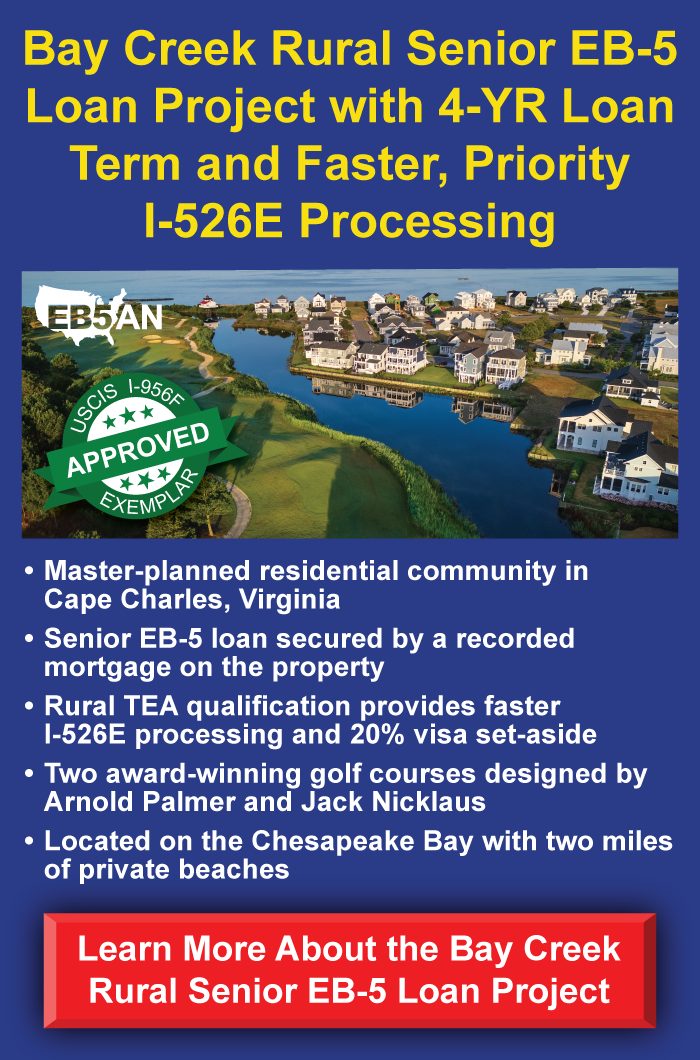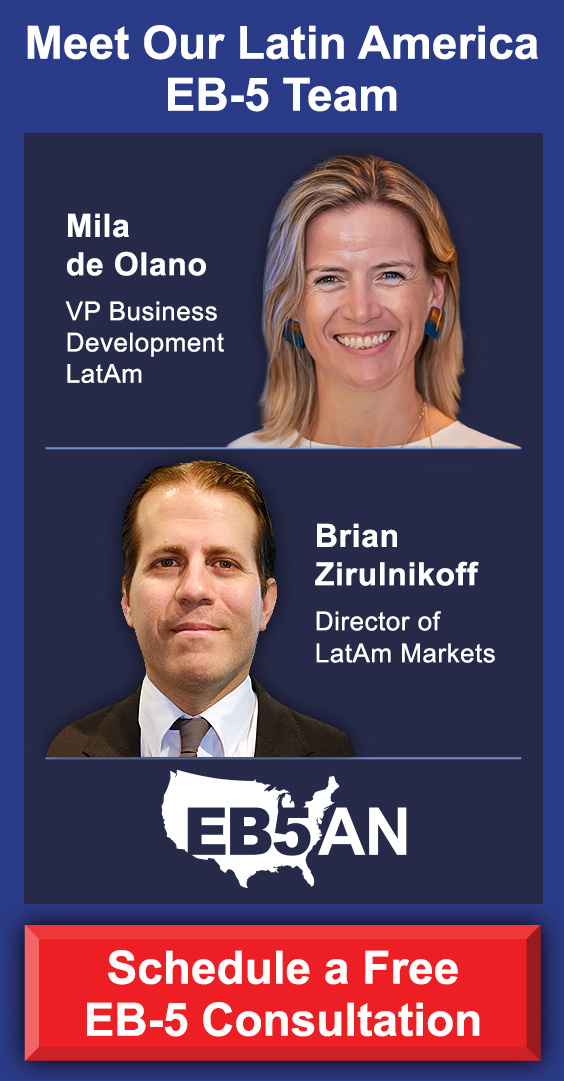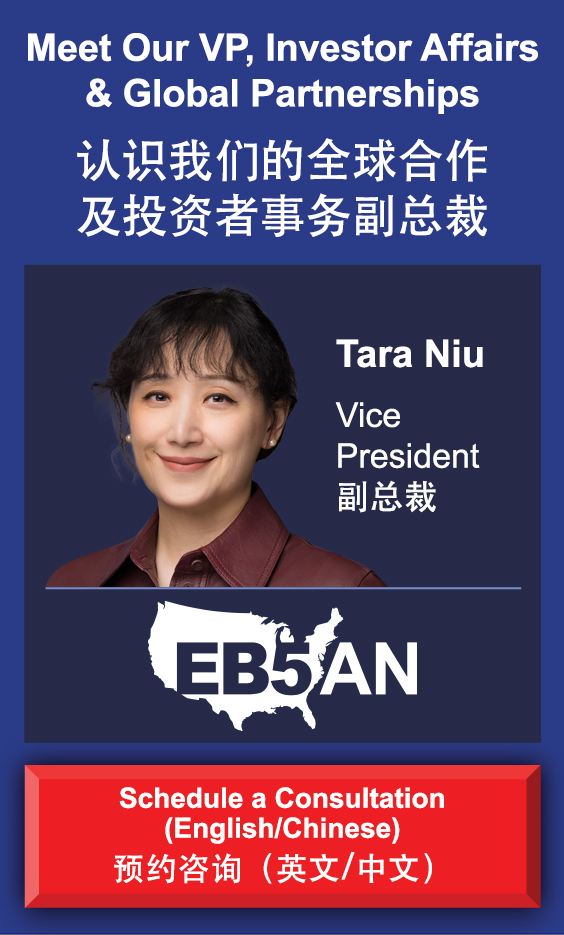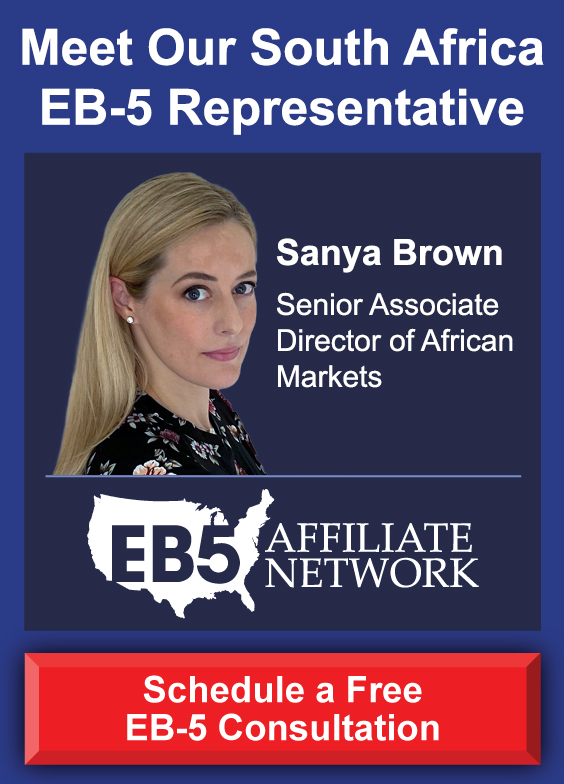Why have over 2,700 EB-5 investors from over 70 countries chosen to work with EB5AN?
Besides EB5AN’s unparalleled project safety, fund oversight, and immigration expertise, one factor consistently stands out: our commitment to helping our EB-5 investors succeed.
Unlike many EB-5 firms, EB5AN enables investors to speak directly with our managing partners and to access our project’s financial statements and other key documents. We believe that our investors deserve the highest possible level of transparency to make informed decisions.
To that end, we are pleased to share the following testimonials from EB-5 investors in our Rocky River project, a rural EB-5 development.
As you’ll notice in the following interviews, each one of these investors carefully evaluated the projects and EB-5 firms on the market before making a decision.
And for each investor, EB5AN’s transparency and commitment to quality were key factors in their decision to work with us.
Rocky River is our premier rural EB-5 project, with a single-family home construction plan similar to our Twin Lakes project. Both are developed by the Kolter Group, the leading builder of single-family active adult communities in the Southeast.
Because Rocky River is a rural EB-5 project, its investors qualify for priority processing. Many investors in our other rural projects have received their U.S. Green Cards within 12 months.
Many industry analysts predict an EB-5 visa backlog for Indian and Chinese nationals. With the largest yearly supply of EB-5 visas, the rural category is the safest for Indian and Chinese investors.
We invite you to take the time to research your options and read the testimonials below. Consider each EB-5 project carefully, including Rocky River. We believe we offer the safest EB-5 projects on the market and would be pleased to answer any questions.
Schedule a free consultation with EB5AN to learn more.

Name: Niharika and Ishaan
From: India
Occupation: H-1B tech professionals
Reason for Investing in an EB-5 Visa: Extremely long backlogs for EB-2 and EB-3
Background: We came on an F-1 visa to pursue our master’s degrees, went to the University of Illinois Urbana-Champaign. And we are currently on an H-1B status along with an EB-2 pathway to a Green Card.
Why EB5AN: The RC needs to educate you on the project, on the nuances, and things like that.
I think by far the EB5AN team and Ahmed—we are primarily working with him—in general, the experience with them was much, much better. We learned a lot about the EB-5 process in general, about these investments, from Ahmed. And this is not just pertaining to the project. It’s in general an overall understanding of what these projects are and the risk.
Then we had follow-up questions. We had multiple sessions with EB5AN. That did not necessarily happen with the other RCs, even the ones with attractive projects
Why Rocky River: We looked at Kolter as a construction group, and we looked at just their past of successful projects.
Again, that gave us a lot of confidence just in the terms of scale and also the terms of volume that they have delivered over the last I think three decades or something. So there’s a lot of background over there that we typically ignored when we were starting off this research. Most of the developers that the other RCs are working with sometimes turned out to be very small, or a brand-new developer is just working on this one project. So compared to that, Kolter seemed to be a lot more familiar and larger name in general
The key difference between those projects and Rocky River is that they’re only going to build, say, the first hundred houses. They will sell those houses, assess how the market is doing, and then build the next tranche.
So that kind of protects you as an EB-5 investor, that it’s not that they’re going to sit on a thousand houses and then wait for them to sell. They’re only going to build as much as they think they can sell in the upcoming time.

Name: Deepak
From: India
Occupation: H-1B worker
Reason for Investing in an EB-5 Visa: Uncertainty and employment/travel restrictions of the H-1B visa.
Background: I grew up in India. We currently live in California. We have a work permit, which is H-1B, and we also have I-140. But as you’re familiar, the Green Card wait is long, and with this work permit, the travel is restrictive, where you have to get stamping, which means there’s a lot of restrictions.
Why EB5AN: What really stood out to me was really the comprehensiveness of each of those documentations, the packages. When you’re trying to really pitch a project across all the regional centers, people just share a sample project, but then you have to ask them a bunch of questions.
But EB5AN … They just give you a link, and it really has every other documentation: the job creation methodology, all the guaranties, the financials, the approvals. There is no you have to ask for a document; it’s already there. That really stood out.
When I spoke with other regional centers, it was more of a sales exercise, them trying to lock me in rather than trying to educate me about the process.
Why Rocky River: One is solid economic fundamentals. Another is really the track record of Kolter. If you’re looking, I think they’re one of the top 20 of the largest real estate companies.
We looked into the documents provided by EB5AN. So number one, it’s Kolter’s track record of doing similar large-scale projects. They have done a lot of projects. It’s like 20-odd projects.
So you’re trying to rinse and repeat the formula with a strong brand, Kolter.
Two, we went to gather the financials. It’s a sound financials, with a lot of projects under their scale.
Also, at the end, the guaranty of the project is Kolter.

Name: Prakash
From: India
Occupation: H-1B worker
Reason for Investing in an EB-5 Visa: Limitations of H-1B visa and extremely long backlog for Indian EB-2 applicants
Background: I ’ve been in the U.S. for the last eight years. I’ve been on L-1, H-1B, and my wife is also on L-2 and H-4, etc. It’s been eight years of journey of this backlog. And then we started evaluating some of these options, because of being on H-1B and the EB-2 priority date is somewhere in like mid-2018. The wait time and the backlog was pretty long. And then we also have a U.S.-born daughter, so we didn’t want to be in the worry of the visa for so long.
Why EB5AN: With EB5AN, I could read through all the different offerings and the project materials and everything online. So EB5AN had different types of projects as well, some with the hotel or a resort one and then some with urban TEA constructions. And this Rocky River is the rural TEA, single-family housing kind of project. All these are somewhat real estate development projects, which I understand a little bit. I have some experience in investing in single-family residences, but I never developed anything. But the offering materials sounded somewhat familiar.
Many other regional centers have different types of project that doesn’t resonate with my experience. That’s one side of the story.
And then I could read through all the different documentation, project materials, read through Kolter, the feedback about the developer. I even chatted with their chatbot to see how they respond to certain … the home sales experiences and everything. Everything felt very positive from Kolter to EB5AN and all that
Why Rocky River: The rural TEA qualification, that was super important for me. As I said before, I already have a U.S.-born daughter who is seven years old. So if I have to go with an urban TEA and still be on the backlog for maybe like nine years—even though it’s current now, the backlog would build up eventually, I believe, and then it could make probably take a few more years to clear up.
But yeah, the urban TEA being current … sorry, the rural TEA being current made this very attractive.
For the Rocky River project, the ability to build these houses based on the demand, that’s something I can see other builders do as well. When you see Lennar or D.R. Horton, you can see how they construct the projects and they adapt the building. I’m on the West Coast, so I haven’t seen the Kolter houses in person yet, so I’m just relating with other builders. So I could see that they can go big when the sales are going on very fast or they can just slow down the investment.

Name: Nagaraju
From: United States
Occupation: H-1B worker
Reason for Investing in an EB-5 Visa: Extremely long backlogs for EB-2 and EB-3 applicants from India
Background: I understand that there is a lot of backlog for EB-2 and EB-3. I’m in EB-2, but since it’s taking so long time, I decided to go through the EB-5 route.
Why EB5AN: We were confident that EB5AN has much more of history and repayments, identifying the projects under EB5AN … So we did actually look at a lot of investors’ profiles—why did they choose EB5AN—and also the documentations that they have provided. So these are the important things that actually made us to narrow down on EB5AN.
Why Rocky River: Interestingly, Kolter Group has already done a good job in Twin Lakes, so that was our template for us. And then when we started to compare Twin Lakes with Rocky River, we understood that both projects are similar. It’s just a new project that’s coming up. So we decided to choose Rocky River because it’s the same template as Twin Lakes.
We thought rural would be more ideal suited for us, because we have a specific criteria that we wanted to meet. And once we had narrowed down on all this, I think Rocky River was more aligned to what our requirements.

Name: Kumar
From: India
Reason for Investing in an EB-5 Visa: Extremely long backlogs for EB-2
Background: For me, I think what happened is my EB-2 petition, which is the employment-based second priority category, was approved in around 2018.
There’s a country cap, which means they don’t give more than a certain number of visas per country. So for India, that is very much backlogged. So my priority date was not current, and it would’ve taken a very long time to become current. So that was one of the reasons why I decided to pursue the EB-5 path.
Why EB5AN: What I found was anyone who visits EB5AN or has interacted with your team will be able to instantly tell … The amount of detail-oriented documentation, information on the YouTube channel, on the page, the responsiveness of the emails is really great.
I did not see that kind of response … I mean, they were all responsive. I’m talking about other regional centers. They were all responsive, but I never got that same amount of detail and responsiveness from any of them. In fact, even some of the prospectus documents which were sent seemed to be lacking a few details, and I had to kind of ask again for them. And in some cases, they weren’t even available or. And that’s fine, but I think in some cases they weren’t even able to tell when they’d be able to get them.
With EB5AN, any question that I had, I was able to communicate through multiple channels, like email or WhatsApp, and always get a reply back or always have a clarification answered.
And in some cases, some of the questions that I asked never even got a reply from other regional centers.
Why Rocky River: The things that really played a key part in my decision was the RIA Act of 2022 specifically states that rural projects get priority processing.
The Rocky River Cresswind community project, it was something that is completed in phases. It’s not done as in … The revenues can start coming in after each phase, which means, once you build a few homes, that those homes can be sold and then the revenues essentially are being generated.
Whereas when I looked at some of the other projects, like a hotel or a travel resort or something like that, they needed to be built completely, because it was like a small parcel of land in some tourist destination where they could not open it up in phases, which means the revenue generation only starts after let’s say two or three years when that project really completes.

Name: Tarun
From: India
Occupation: Tech Professional on STEM OPT Program
Reason for Investing in an EB-5 Visa: Uncertainty of H-1B, EB-1, O-1, and similar visas
Background: One visa option was the H-1B, another one was the O-1 route as well, which could be later termed as EB-1A. In my past two years where majority of layoffs have happened across tech, I’ve seen that it creates a lot of uncertainty for H-1B workers. Especially people in the United States where you have just 60 days to find a new job.
So those are the options I considered and looking at that, hey, I’m not eligible for even O-1 or EB-1A and even if I get an H-1B, the end goal, if I want to stay here in the long term, it is not going to be satisfied with H-1B. And that’s how I discovered the EB-5 program.
Maybe your H-1B is taking too long, or you don’t qualify for the O-1, EB-1A criteria and just want some stability in life and just a peace of mind. So then comes down to the question, what price do you put on peace of mind?
Why EB5AN: When I started my initial research in May, my entire research was based on EB5AN’s YouTube videos, their website, and got to know a lot of information. So I was like, hey, these guys know this stuff. They have the credentials, they know this stuff. They’ve been doing this for 10 years. So I was like, okay, these folks meet all the criteria that I was looking for. What is the success rate? What is a philosophy on picking developers and deciding to work with them? So you are always looking for the best interest for the client that you’re working with.
Just working with the EB5AN and they’ve done all the research, they picked the good projects for you. Now you have to just decide between, hey, you want to pick a rural project or urban project.
Why Rocky River: Given the developer Kolter’s track record, I was like, okay, they can build it, can they sell it? So we have seen that with Twin Lakes and every other property that they are able to sell it. And the way they look at markets and the positioning that they do is closer to the airport and makes it much more easier for people to make the buying decision that, hey, this is the right home for me. It’s a trusted developer.
They’ve done this project in the past, they know what they’re doing and they know that’s going to… It’s like probability of success. I know that the probability of success is much more higher with Rocky River when I invest with them.

Name: Anoop
From: India
Reason for Investing in an EB-5 Visa: Extremely long backlogs for EB-2
Background: I moved to the US in 2015 on an L-1B visa. It was an intra-company transfer. So I was working for the same company back in India and I got transferred to the California San Jose office here. I came on L-1B. My wife was on an L-2 visa.
I started with L-1B and then it took few years for me to even move to H-1B because there is a lottery process. So it took at least three years for me to get to H-1B and even to get my permit and I-140 approved. So from 2018 I moved on to my H-1B plus E-B2 priority category. I’m on the waiting list of the E-B2 priority from 2018. The dates have moved back to 2011 and 2012.
Why EB5AN: Your website provided a lot of information which really helped educate myself on it. But compared to that other regional centers just at maybe few lines about the project and not much information about the whole process and timelines and everything. The EB5AN website had content and details and specifics about projects and construction updates about projects. That was a clear difference between EB5AN and other groups.
Why Rocky River: The developer Kolter, within your projects or even outside, they had that good track record with respect to completing the projects and especially EB-5 projects.
And then I went and looked at all their existing projects and previously completed projects from Kolter in their leadership team. And it all looked very promising to me compared to other projects, where they have been going on at the construction for a few years and when they run out of funds, they go to EB-5 route to raise additional funds. With Kolter that never happened. It was always very financially well positioned loans.
When I was studying EB-5 data, everything mentioned this urban numbers were twice the pending request, the pending applications for the urban were twice compared to the rural one, even though rural had 20% set aside and everyone was expecting urban to get into a backlog situation pretty soon for India and China.
That pushed me to say, “Okay, rural and nothing else because that had 20% set aside.”






